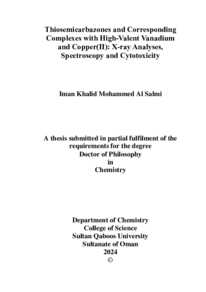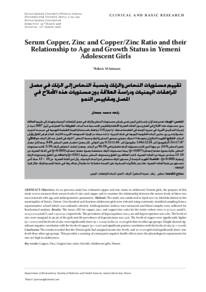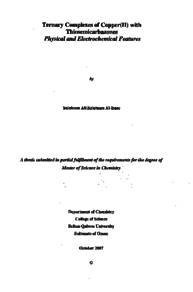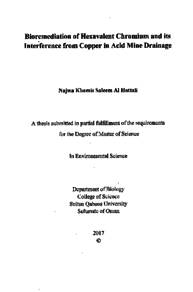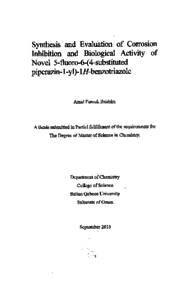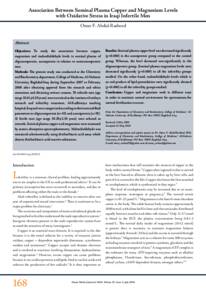Document
Thiosemicarbazones and corresponding complexes with high-valent vanadium and copper(II) : X-ray analyses, spectroscopy and cytotoxicity.
Source
Doctoral dissertation
Country
Oman
City
Muscat
Publisher
Sultan Qaboos University
Gregorian
2024
Language
English
Subject
Thesis Type
Doctoral dissertation
English abstract
This research endeavour was motivated to a large extent by the paucity of
thiosemicarbazone-based ternary complexes of copper(II) and oxovanadium(IV) with
bidentate co-ligands (N,N-donor) such as 1,10-phenanthroline (phen), 2,2ˊ-bipyridine
(bipy), dipyridoquinoxaline (dpq) and dipyridophenazine (dppz), or their derivatives.
Even rarer are phenolate-possessing thiosemicarbazone complexes with these
aforementioned transition metals. Considering the inherent pharmacological
properties of thiosemicarbazones and the N,N-donor co-ligands as well as the
bioactivities of copper and vanadium, such ternary complexes, [CuII(L)(N,N-donor)]n+
and [VIVO(L)(N,N-donor)]n+, were anticipated to exhibit potentially fascinating
biological properties. Given the electrochemically accessible multiple electrovalencies
of copper and vanadium, redox processes of thiosemicarbazone complexes of these
transition metals were envisaged to play a key role in the generation of reactive oxygen
species (ROS) responsible for apoptotic cytotoxicity. Additionally, the development
of high-valent vanadium coordination chemistry based on thiosemicarbazones was
another important aspect of this work with emphasis on interesting structural,
spectroscopic, redox and antiproliferative properties.
The anticancer agent di(2-pyridyl) ketone 4,4-dimethyl-3-thiosemicarbazone
(HDpk44mT), a series of variously-substituted salicylaldehyde 4,4-dimethyl-3-
thiosemicarbazones [H2(3,5-R
1
,R2
)-sal44mT: R1 = R2 = H; R1 = H, R2 = OMe; R1 = H,
R
2 = NO2; R1 = H, R2 = t-Bu; R1 = t-Bu, R2 = H; R1 = R2 = t-Bu] and 3,5-di-tertbutylsalicyladehyde 4-ethyl-3-thiosemicarbazone [H2(3,5-t-Bu2)-sal4eT] were
produced straightforwardly by the usual one-pot Schiff-base condensation reaction and
isolated in the thio-keto (thione) tautomer as evidenced by vibrational spectroscopy
which gave stretching frequencies in the range 3100–3250 cm–1
attributable to the
hydrazinic thio-amide N–H bonds. 1H-NMR spectroscopy (700 MHz) revealed that
the structures of these ligands remain intact in solution. The single-crystal X-ray
structures of H2(3,5-t-Bu2)-sal44mT and H2(3,5-t-Bu2)-sal4eT not only confirmed the
existence of the thione tautomer (C=S: 1.701 and 1.703 Å, respectively), but also
showed that these molecules crystallise in the E-configuration; however, they adopt
different conformations with different orientations of the thio-amide functionality. In
both structures, the ligands exhibit intramolecular H-bonding between the phenol
proton and the imine nitrogen. Hence, for all the ligands, the chemical shift of the
phenol proton is the most downfield, followed by that of the thio-amide N–H proton.
A clear trend of the electronic effects of the substituent groups (R1
and R2
on the
chemical shifts is established. In the case of the di(2-pyridyl)-based ligand
HDpk44mT, the two pyridyl moieties are nonequivalent: the proton adjacent to the
pyridyl nitrogen which is H-bonded to the thio-amide N–H group is more deshielded
(δ 8.8 vs. 8.6).
Reactions of the phenolic thiosemicarbazones with [VO(acac)2] in the presence of a
bidentate co-ligand in equimolar amounts afforded a series of mononuclear molecular
oxovanadium(IV) complexes of the type [VO{(3,5-R
1
,R2
)-sal44mT}(N,N-donor)] and
[VO{(3,5-R
1
,R2
)-sal4eT}(N,N-donor)] (where N,N-donor = phen, 4,4ˊ-Me2-2,2ˊbipy). Evidently, the thiosemicarbazones underwent tautomeric transformations
concomitantly with deprotonation for charge-neutrality. [VO{(3,5-t-Bu2)-
v
sal44mT}(phen)], [VO{(3-t-Bu2)-sal44mT}(phen)] and [VO{(3,5-t-Bu2)-
sal4eT}(phen)] are the first examples of crystallographically elucidated ternary
complexes of their kind (excluding the only three known for the closely related
thiosemicarbazate class of ligands). The geometry at the metal centre is distorted
octahedral with phen adopting an axial-equatorial coordination mode. The transinfluence of the vanadyl oxygen [d(V=O) ~1.60] causes a conspicuous difference
between the V–Nphen distances [Δd(V–N) ~0.19–0.23 Å]. The crystal lattice of all three
complexes exhibits π-π stacking interactions involving the phen ligand. As expected,
the well-resolved X-band ESR spectra of the representative complexes [VO{(3,5-tBu2)-sal44mT}(phen)] and [VO{(3,5-t-Bu2)-sal4eT}(phen)] are axial with Az>>Ax,y
for the [Ar]3d
1
configuration consistent with a dxy ground state. Treatment of H2(3-tBu)-sal44mT and H2(3,5-t-Bu2)-sal44mT with half a molar equivalent of [VO(acac)2]
in MeCN caused spontaneous deoxygenation of the vanadyl ion to produce the nonoxo vanadium(IV) bis(chelate) binary complexes [V{(3-t-Bu)-sal44mT}2] and
[V{(3,5-t-Bu2)-sal44mT}2], respectively. These have been crystallographically
characterized and are the first examples of thiosemicarbazone complexes of this kind.
Previously, two papers reported similar thiosemicarbazate complexes. The
coordination geometries are intermediate between distorted octahedral and trigonal
prismatic, but the distortion is leaning more in favour of the latter. Indeed, in frozen
DMF solution, X-band ESR spectroscopy detected the trigonal prismatic structure
(Ax,y >> Az: dz2 ground state). Cyclic voltammetry revealed two redox processes
attributable to the anodic VIV/VV
and cathodic VIV/VIII redox couples. Reactions of the
phenolic thiosemicarbazones with equimolar equivalents of [VO(acac)2] in MeOH
afforded the oxovanadium(V) methoxide complexes [VO{(3,5-R
1
,R2
)-
sal44mT}(OMe)], of which [VO{(3-t-Bu)-sal44mT}(OMe)] and [VO{(5-OMe)-
sal44mT}(OMe)] were characterized by X-ray crystallography. When these reactions
were conducted in the presence of Et3N, the ionic complexes of dioxovanadium(V)
[Et3NH][VO2{(3,5-R
1
,R2
)-sal44mT}] were formed. The 3-D structure of the complex
[Et3NH][VO2{(3,5-t-Bu2)-sal44mT}] was determined definitively by X-ray analysis.
The coordinate bond to the oxygen hydrogen-bonded of the triethylammonium counter
cation was considerably weakened. In the case of HDpk44mT, the formation of
[VO2(Dpk44mT)] occurred in the absence of a base. The structure of
[VO2(Dpk44mT)] was also determined by X-ray crystallography. Each of the
abovementioned vanadium(V) complexes are diamagnetic and were characterized by
1H-NMR spectroscopy; additionally, a selected few were characterized by 51V-NMR
spectroscopy.
Each of the ligands H2(3,5-R
1
,R2
)-sal44mT was treated with (CH3COO)2Cu·H2O
followed immediately by the addition of a bidentate co-ligand (N,N-donor = phen, 2,9-
Me2-phen, bipy or 4,4ˊ-2,2´-bipy) in stoichiometric amounts to produce the
mononuclear ternary copper(II) complexes [Cu{(3,5-R
1
,R2
)-sal44mT}(N,N-donor)].
However, in the case of the ligand H2(3,5-t-Bu2)-sal4eT, the reaction afforded the
dinuclear complex, [Cu2{(3,5-
tBu2)-sal4eT}2(phen)]. In these reactions, the acetate ion
served as a base that assisted tautomerisation. As an illustration of this point, the
reaction of H2(3,5-t-Bu2)-sal44mT with Cu(ClO4)2·6H2O in the presence of phen
under the same conditions, gave the ionic complex [Cu{H(3,5-t-Bu2)-
sal44mT}(phen)]ClO4 in which the ligand remained in the thione tautomeric form;
only the phenol moiety was deprotonated. The X-ray structures of the mononuclear
ternary complexes show meridional coordination of the donor atoms of the
thiosemicarbazone ligand and axial-equatorial coordination of the donor atoms of the
vi
co-ligand giving rise to a distorted square pyramidal geometry at the metal centre with
the trigonality index [τ = (β – α)/60º] varying from 0.018 for the unsubstituted complex
to 0.375 for the tert-butyl-substituted complexes. All of these copper(II) complexes
are subject to the Jahn-Teller effect as evidenced by the elongation of the axial Cu–
Nco-ligand causing a difference in the two Cu–Nco-ligand distances ranging from 0.247 to
0.313 Å. X-band ESR spectroscopy has demonstrated that the 3-D structure is
maintained in solution given the axial spectra (gǁ > gꞱ > 2.0; Aǁ > AꞱ) which, together
with the X-ray structures, are indicative of half occupancy of the dx2–y2 orbital in the
ground state. The dinuclear complex [Cu2{(3,5-
tBu2)-sal4eT}2(phen)] exhibits a
distorted square planar coordination sphere at one copper(II) centre and a distorted
square pyramidal geometry (τ = 0.33) at the other copper(II) centre. This is one of only
two known structurally characterised dinuclear copper(II) phenolate-based
thiosemicarbazone complexes of this type. The mononuclear copper(II) complexes
have RT effective magnetic moments in the range 1.66 to 1.89 µB as expected for a d9
system. The value of µeff for the dinuclear complex (2.38 µB) is very close to the spinonly value for two non-interacting copper(II) paramagnetic centres. All the copper(II)
complexes display colours ranging from light yellow to orange-yellow largely on
account LMCT near-visible or visible absorptions.
The cytotoxicity of selected thiosemicarbazone ligands and corresponding complexes
with copper(II) and vanadium(IV/V) was investigated in two cancer cell lines, namely
human cervical carcinoma (HeLa) and human breast adenocarcinoma (MCF-7),
together with the normal (noncancerous) human breast epithelial cell line (MCF-10A)
in some cases, using the MTT cell viability assay. Whereas the di(2-pyridyl)-based
ligand HDpk44mT was highly antiproliferative towards these cancer cells, the
phenolic thiosemicarbazone ligands gave IC50 values greater than 100 µM indicative
of lack of activity. However, the phenolate-possessing thiosemicarbazone complexes
exhibited anticancer activity. Generally, the copper(II) complexes exhibited higher
cytotoxicity than their vanadium counterparts. It is also noteworthy that the ternary
complexes containing bipy or 4,4`-Me2-bipy were less potent than those having phen
or 2,9-Me2-phen. A comparative photocytotoxicity investigation using the HeLa
cancer cell line revealed that [VO{(3,5-
tBu2)-sal44mT}(phen)] exhibits apoptotic
photodynamic behavior whereas [Cu{(3,5-
tBu2)-sal44mT}(phen)] does not. Finally,
most of the complexes showed inhibitory activity against either Escherichia coli or
Staphylococcus aureus or both.
Arabic abstract
إن الدافع الرئيس وراء هذا المسعى البحثي إلى حد كبير هو ندرة المركبات الثلاثية القائمة على مرتبطات VO (أو 2+ الثيوسيمي كربزون (thiosemicarbazones (والمحتوية على الفناديوم الاكسجيني الرباعي ( Cu (إضافة إلى المرتبطات الثنائية المساعدة (donor-N,N (مثل الفين (phen (أو البايبيرديل II النحاس الثنائي( (bipy (أو البايبيريديل كوينوكسيلين (dpq (أو دايبيريدوفينازين (dppz (أومشتقاتها. ومن الجدير بالذكر أن الاكثر ندرة هي المركبات الثلاثية المحتوية على ثيوسيمي كربزون ذات شطر الفينول مع الفلزات الانتقالية آنفة الذكر مع الاخذ في الاعتبار الخصائص الدوائية المتأصلة والمثبتة للثيوسيمي كربزونات والمرتبطات الثنائية المساعدة بالاضافة للنشاط الحيوي المعروف للفناديوم والنحاس. العامة الصيغة ذات الثلاثية المركبات فإن لذلك n+ (L)(N,N-donor)] II و] Cu n+ O(L)(N,N-donor)] IV [V يتوقع أن تبدي خصائص دوائية رائعة ومثيرة لالهتمام. ونظرا لوجود أكثر من حالة تأكسد يمكن الوصول إليها كهروكيميائيا لكل من النحاس والفناديوم فإنه من المتوقع أن تلعب عمليات الاكسدة والاختزال لهذه المركبات دورا جوهريا في توليد أنواع الاكسجين التفاعلية (ROS (المسؤولة عن السمية الخلوية للخاليا. إضافة إلى ذلك فإن المساهمة في تطوير علم كيمياء المركبات التناسقية للفناديوم ذو حالات التأكسد العالية والمحتوية على الثيوسيمي كربزون يعتبر أحد الجوانب الاخرى المهمة لهذا المشروع البحثي مع التركيز على الخصائص التركيبية والهيكلية والطيفية وخواص الاكسدة والاختزال والخصائص المضادة لتكاثر الخاليا السرطانية. ويعتبر كل من: العامل المضاد للخاليا السرطانية )مرتبطة الثيوسيمي كربزون المحتوية على شطر بيريديل(: ثنائي )-2بيريديل( كيتون -4،4ثنائي ميثيل-3- ثيوسيمي كربزون )mT44HDpk )وسلسلة الساليسيل ألدهيد المكونة من مرتبطات الثيوسيمي كربزون ذات شطر الفينول المحتوية على مجموعات استبدالية متنوعة: -4،4 ثنائي ميثيل-3-ثيوسيمي كربزونات mT44sal-) 2 ,R1 :حيث] H2(3,5-R R 1 = R2 = H; R1 = H, R2 = OMe; R1 = H, R2 = NO2; R1 = H, R2 = t-Bu; R1 = t-Bu, R2 = H; R1 = R2 = t-Bu] إضافة إلى -3,5ثنائي-3-ب يوتيل ساليسيل ألدهيد -4إيثيل-3-ثيوسيمي كربزون [eT4sal-)2Bu-t3,5-(2H [قد تم تصنيعها جميعا عن طريق تفاعل التكثيف المباشر المستخدم عادة لتحضير مركبات "الشيف بيس" وتم عزلها بالصورة التحولية ثيو-كيتو )ثايون( (thione (keto-thio وهذا ما تم تأكيده عن طرق قياسات الطيف التذبذبي )spectroscopy vibrational )الذي أظهر ترددا بين 3100 و –1 والذي يعزى لرابطة هيدرازينك 3250 cm 1 ثيو-أمايد H–N. وقد أثبت طيف مغناطيسية النواة الترددي للبروتون )spectroscopy NMR-H ( عند 700 ميجاهيرتز أن هذه المرتبطات حافظت على تركيبها الكيميائي سليما في المحلول. إن التركيب الكيميائي المثبت باستخدام مطياف الاشعة السينية الثنين من هذه المرتبطات وهي -(2Bu-t3,5-(2H mT44sal و eT4sal-)2Bu-t3,5-(2H لم يثبت وجودها في الصورة التحولية ثايون (thione (فحسب وإنما أظهر كذلك أن هذه المركبات تبلورت على شكل التكوين الالكتروني من نوع E( configuration-E( )طول الرابطة S=C فيهما هو 1.701 و 1.703 أنجستروم على التوالي( ومع ذلك فهي تعتمد مطابقات مختلفة واتجاهات فراغية متنوعة تبعا لوظيفة الثيو أمايد. في كال التركيبين تظهر الروابط الهيدروجينية داخل الجزيئات بين بروتون الفينول ونيتروجين الامين، ومن ثم فإن جميع مرتبطات الثيوسيمي كربزون تظهر المؤشر الكيميائي الاكثر انخفاضا لبروتون الفينول يليه مؤشر بروتون الثيو أمايد )H–N). كما خلصنا إلى معرفة اتجاه واضح للتأثيرات 1 الالكترونية للمجموعات البديلة R و 2 R على هذه المؤشرات الكيميائية. في حالة الثيوسيمي كربزون من نوع بيريديل ) mT44HDpk )فإن شطري البيريديل غير متماثلين بحيث أن البروتون القريب من نيتروجين البيريديل والذي يرتبط برابطة هيدروجينية مع مجموعة الثيو-أمايد )H–N )هو الاكثر عرضة للتأثير المغناطيسي ويظهر مؤشرا كيميائيا 8.8 δ في مقابل 8.6 δ. إن تفاعالت الثيوسيمي كربزونات الفينولية مع [2(acac(VO [في وجود المرتبطات الثنائية المساعدة بكميات مولية متساوية قد أنتجت سلسلة من مركبات الفناديوم الاكسجيني الرباعي أحادية الفلز ذات الصيغة العامة viii )-sal44mT}(N,N-donor)] 2 ,R1 )-sal4eT}(N,N-donor)] و] VO{(3,5-R 2 ,R1 [VO{(3,5-R حيث donor-N,N عبارة عن الفن )phen )أو-4،4ثنائي ميثيل-2،2-ثنائي بيريديل )bipy-ˊ2-2,2Me-ˊ4,4). من الواضح أن مرتبطات الثيوسيمي كربزون قد خضعت لتحوالت في الصيغة التركيبية بالتزامن مع نزع البروتونات لغرض موازنة شحنة أيون الفلز. ثالثة من مركبات الفناديوم الاكسجيني الرباعي المحضرة في هذا المشروع تعد أول مركبات من هذا النوع يتم اثبات تركيبها الجزيئي عن طريق مطياف الاشعة السينية )باستثناء ثالثة مركبات شبيهة معروفة مسبقا قائمة على مرتبطات الثيوسيمي كربزيت(. هذه المركبات هي: [VO{(3,5-t-Bu2)-sal44mT}(phen)] و] VO{(3-t-Bu2)-sal44mT}(phen)] و] VO{(3,5-t Bu2)-sal4eT}(phen)] . إن الشكل الهندسي عند مركز الفلز في هذه المركبات هو شبه هرم ثماني الاوجه حيث ترتبط المرتبطات المساعدة من نوع "فين" phen بذرة الفناديوم المركزية عن طريق ذرتيها المانحة في وضع رأسي وأفقي. تأثير الرابطة الثنائية O=V( طولها تقريبا 1.60 أنجستروم( في المستوى المحوري الرأسي يؤدي إلى استطالة في الرابطة المقابلة لها وهناك اختالف واضح في أطوال الروابط Nphen–V حيث تتراوح بين 0.19 إلى 0.23 أنجستروم. تظهر الشبكات البلورية لجميع هذه المركبات وجود تجاذب من نوع π-π( interactions stacking π-π )بين مرتبطات الفين phen بين جزيء وآخر لهذه المركبات. كما هو متوقع فإن قياسات الرنين الالكتروني المغزلي [VO{(3,5-t-Bu2)-sal4eT}(phen)] و] VO{(3,5-t-Bu2)-sal44mT}(phen)] للمركبات( ESR( 1 ذات التوزيع الالكتروني d3]Ar [تظهر ذبذبة محورية رأسية )axial )تثبت وجود الالكترون المفرد الوحيد نصف مع H2(3,5-t-Bu2)-sal44mT و H2(3-t-Bu)-sal44mT من كل مفاعلة إن .dxy الطاقة مستوى في الكمية الموالرية من [2(acac(VO [في محلول أسيتونيتريل هو تفاعل صاحبه انتزاع تلقائي لألكسجين من ( VO )أدى إلى إنتاج مركبات ثنائية للفناديوم الرباعي عديم الاكسجين [2{mT44sal-)Bu-t3-{(V [و 2+ [2{mT44sal-)2Bu-t3,5-{(V [على التوالي. هذه المركبات تعتبر أول مركبات من هذا النوع يتم إثبات تركيبها الجزيئي باستخدام مطياف الاشعة السينية. وقد نشرت ورقتين علميتين سابقا لمركبات شبيهة ولكن تحتوي على الثيوسيمي كربزيت بدال من الثيوسيمي كربزون. يمكن وصف التركيب الجزيئي الهندسي لهذه المركبات حول ذرة الفناديوم المركزية بأنه وسط بين شبه هرم ثماني الاوجه وشبه منشور مثلثي مزدوج وإن كان يميل للشكل الهندسي الاخير بشكل أكبر. وقد أثبت التحليل الطيفي للرنين الالكتروني المغزلي )ESR )لهذه المركبات في محلول ثنائي ميثيل فورماميد المجمد )DMF )وجود ذبذبة محورية رأسية تدل على تركيب شبه منشور مثلثي مزدوج مع قيم y,Ax أكبر بكثير من قيم Az ووجود الالكترون الوحيد في مستوى الطاقة 2dz. كشف قياس الجهد الدوري الكهربائي عن وجود نشاط لهذه المركبات في المرور بعمليتي أكسدة واختزال بشكل V تبادلي شبه كامل يعزى ألزواج الايونات /V V عند المصعد و IV III /V Vعند المهبط. IV إن تفاعالت الثيوسيمي كربزونات مع كمية موالرية مكافئة من [2(acac(VO [في محلول الميثانول أنتج مركبات الفناديوم الخماسي الاكسجيني المحتوية على مجموعة الميثوكسيد ذات الصيغة العامة 3,5-)}VO[ )-sal44mT}(OMe)] 2 ,R1 R حيث تم اثبات التركيب الجزيئي الثنين من هذه المركبات بواسطة مطياف .[VO{(5-OMe)-sal44mT}(OMe)] و] VO{(3-t-Bu)-sal44mT}(OMe)] وهي السينية الاشعة حينما تمت هذه التفاعالت في وجود ثالثي ميثيل أمين )N3Et )نتجت المركبات الايونية للفناديوم الخماسي ثنائي 2 الاكسجين ذات الصيغة العامة [{mT44sal-) ,R1 R3,5-{(2VO][NH3Et [حيث تم اثبات التركيب الجزيئي ثالثي الابعاد للمركب [{mT44sal-)2Bu-t3,5-{(2VO][NH3Et [بواسطة تحليل مطياف الاشعة السينية. الرابطة بين ذرة الفناديوم المركزية وإحدى ذرتي الاكسجين ضعفت بسبب وجود رابطة هيدروجينية بينها وبين أيون ثالثي إيثيل الامونيوم الموجب. في حالة المرتبطة mT44HDpk فإن تحضير المركب [(mT44Dpk(2VO [تم في غياب القاعدة ثالثي ميثيل أمين )N3Et )وقد تم كذلك إثبات التركيب الجزيئي لهذا المركب باستخدام مطياف الاشعة السينية. جميع مركبات الفناديوم الخماسي آنفة الذكر ليس لها نشاط 1 مغناطيسي لذلك أمكن تحليلها باستخدام طيف مغناطيسية النواة الترددي للبروتون ) NMR-H 51 spectroscopy )وعدد مختار منها تم تحليله بواسطة طيف مغناطيسية النواة الترددي للفناديوم 51 )-V .)NMR spectroscopy 2 وقد تم مفاعلة كل من مرتبطات الثيوسيمي كربزون ذات الصيغة العامة mT44sal-) ,R1 مع H2(3,5-R N,N- حيث )N,N-donor المساعدة الثنائية المرتبطات بإضافة مباشرة متبوعا) CH3COO)2Cu·H2O ix phen = donor أو phen2-Me2,9- أوbipy أو bipy-´-2,2ˊ4,4 ) لتحضير المركبات الثلاثية أحادية 2 الفلز للنحاس الثنائي ذات الصيغة العامة [(donor-N,N}(mT44sal-) ,R1 R3,5-{(Cu[. وفي حال استخدام المرتبطة eT4sal-)2Bu-t3,5-(2H فإن التفاعل قد أنتج مركب ثالثي ثنائي الفلز للنحاس الثنائي وهو Bu2)-sal4eT}2(phen)] t 3,5-)}2Cu[. في جميع هذه التفاعالت فإن أيون الاسيتات قد لعب دور القاعدة المحفزة لتغيير مرتبطات الثيوسيمي كربزون بين صورها التحولية. كتوضيح لهذه الفكرة وكمقارنة فإن تفاعل ظروف نفس وتحت( phen( الفين مرتبطة وجود في Cu(ClO4)2·6H2O مع H2(3,5-t-Bu2)-sal44mT التفاعل قد أنتج المركب الايوني 4ClO)]phen}(mT44sal-)2Bu-t3,5-(H{Cu [حيث بقيت فيه مرتبطة الثيوسيمي كربزون في الصورة التحولية ثايون )thion )ونزع البروتون تم فقط من الشطر الفينولي للمرتبطة. تحليل مطياف الاشعة السينية للمركبات الثلاثية أحادية الفلز للنحاس الثنائي أثبتت أن التركيب الجزيئي لها هو شبه هرمي رباعي القاعدة حيث ترتبط الذرات المانحة من مرتبطات الثيوسيمي كربزون بشكل تناسقي )meredional )بين ما تتخذ المرتبطات الثنائية المساعدة )phen أو phen2-Me2,9- ) وضعية ارتباط في كال المستويين الافقي )equatorial )والمحوري الرأسي )axial )مع مؤشر زاوي )index trigonality )يتراوح بين 0.018 للمركب الذي ال يحتوي على مجموعات بديلة إلى 0.375 للمركب المحتوي على مجموعات البيوتيل الثالثي. هذه المركبات تظهر انحرافا من نوع يان-تيلر على طول المحور الرأسي )distortion Teller-Jahn ) مما يؤدي إلى تنسيق غير متماثل للمرتبطات الثنائية حيث أن Nax–Cu أطول من Neq–Cu كما هو متوقع 9 لمركبات النحاس الثنائي ذات التوزيع الالكتروني ) d )حيث تتراوح أطوال هذه الروابط من 0.247 إلى 0.313 أنجستروم. ودعما لنتائج الاشعة السينية فإن قياسات الرنين الالكتروني المغزلي )ESR )لهذه المركبات تشير كذلك إلى شكل بنائي جزيئي عبارة عن شبه هرمي رباعي مع قيم المعامالت 2 < ┴g║ > g و┴A║ > A ووجود t الالكترون المفرد الوحيد يحتل مستوى الطاقة 2y2-dx. المركب [(phen(2}eT4sal-)2Bu 3,5-)}2Cu [يتخذ شكال هندسيا يوصف بأنه شبه هرمي رباعي حول أحد أيونات النحاس الثنائي المركزية )0.33 = τ )وشبه مربع مستوي حول أيون النحاس الاخر كما يتضح من تحليل طيف الاشعة السينية. وهذا المركب يعد أحد مركبين فقط من هذا النوع تم إثبات تركيبهما الجزيئي عن طريق مطياف الاشعة السينية ويحتويان على مرتبطات الثيوسيمي كربزون الفينولية. ليس هناك تفاعال مغناطيسيا بين أيوني النحاس المركزيين في هذا المركب وهو ما تثبته قيم المغناطيسية μeff حيث أن لها قيمة تساوي μB 2.38 وهي قيمة قريبة جدا من القيمة المحسوبة نظريا والمتوقعة أما لمركبات النحاس الثنائي أحادية الفلز فإن قيم المغناطيسية المقاسة لها في درجة حرارة الغرفة فتتراوح 9 بين μB 1.66 وμB 1.89 كما هو متوقع لنظام d. جميع مركبات النحاس الثنائي لها ألوان تتراوح بين الاصفر الباهت إلى الاصفر البرتقالي بسبب انتقال الالكترونات من المرتبطة إلى الفلز نتيجة امتصاص الطاقة في منطقة الطيف المرئي أو قريبا منها. تم اختبار تأثير عدد من مرتبطات الثيوسيمي كربزون ومركباتها من الفناديوم والنحاس على نوعين من الخاليا السرطانية البشرية هما خاليا سرطان عنق الرحم )HeLa )وخاليا سرطان الغدد الثديية )-7MCF )بالاضافة إلى خاليا غدد الثدي الطبيعية غير السرطانية )A-10MCF )في بعض الحالات وذلك باستخدام اختبار MTT. ومن الجدير بالذكر أن مرتبطة الثيوسيمي كربزون المحتوية على شطر بيريديل )mT44HDpk )أبدت نشاطا عاليا وملحوظا مضادا لهذه الخاليا السرطانية بينما أبدت مرتبطات الثيوسيمي كربزون الفينولية قيم )50IC ) تتجاوز µM 100 مما يدل على تأثيرها الضعيف المضاد للخاليا السرطانية. بالرغم من ذلك فإن مركبات النحاس والفناديوم المحتوية على هذه المرتبطات الفينولية قد أبدت نشاطا مضادا للخلايا السرطانية. وبشكل عام فقد كانت مركبات النحاس الثنائي ذات تأثير مضاد للخاليا السرطانية أعلى من النشاط الذي أبدته مركبات الفناديوم المناظرة لها. ومن الجدير بالذكر كذلك أن المركبات الثلاثية المحتوية على bipy أو bipy2-Me-`4,4 قد أبدت نشاطا أقل ضد الخاليا السرطانية من تلك المركبات المحتوية على phen أو phen2-Me.2,9- كما أن نتائج دراسة مقارنة تأثير السمية الخلوية الضوئية على خاليا سرطان عنق الرحم البشري )HeLa )ألحد مركبات الفناديوم الرباعي الاكسجيني الثلاثية و أحد مركبات النحاس الثنائي الثلاثية فقد جاءت النتائج لتوضح أن مركب الفناديوم Bu2)-sal44mT}(phen)] t 3,5-)}VO [قد أبدى نشاطا ديناميكيا ضوئيا مضادا للخاليا السرطانية بينما قل t هذا التأثير في الظالم بينما أبدى المركب [(phen}(mT44sal-)2Bu 3,5-)}Cu [نفس التأثير المضاد لهذه الخاليا سواء في الضوء أو في الظالم. كما تم اختبار نشاط عدد من مرتبطات الثيوسيمي كربزون وعدد من مركبات الفناديوم والنحاس ضد نوعين من سالسل البكتيريا وهي البكتيريا القولونية )coli Escherichia ) وبكتيريا المكورات العنقودية الذهبية )aureus Staphylococcus )وقد أظهرت النتائج أن غالبية هذه المركبات تمتلك نشاطا سميا مثبطا إلحدى نوعي السالسل البكتيرية أو كلاهما.
Category
Theses and Dissertations

